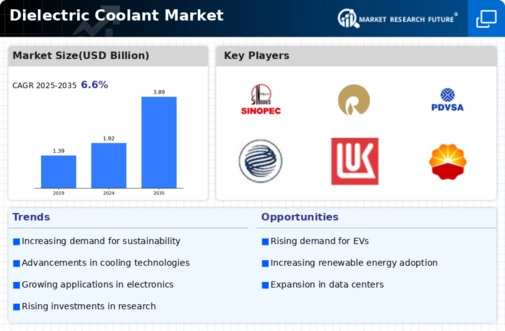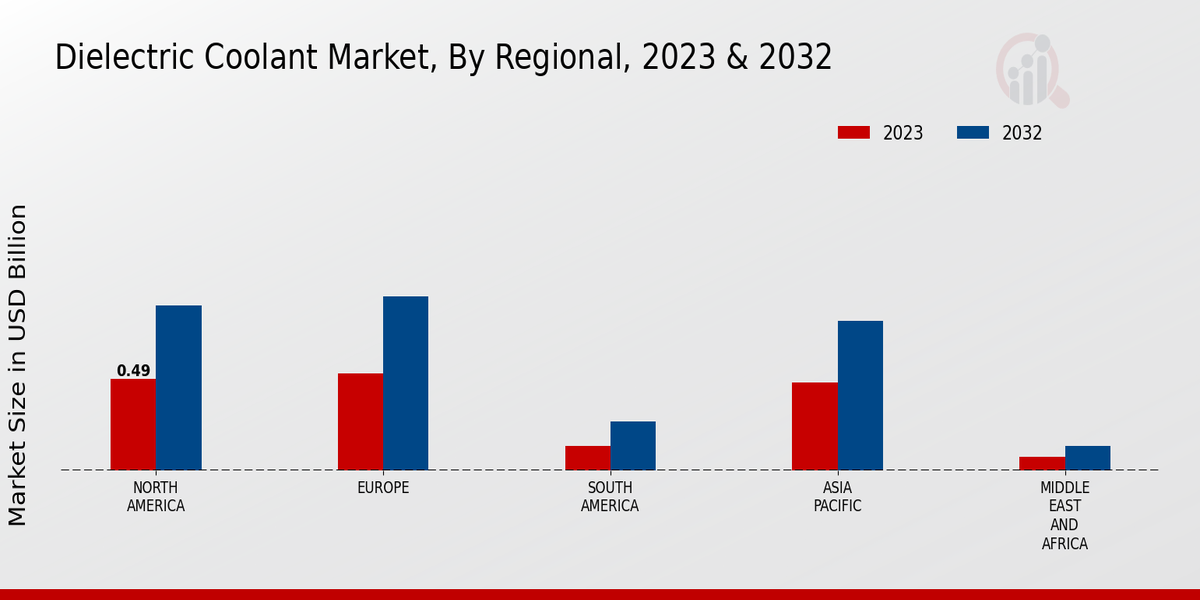Market Growth Projections
The Global Dielectric Coolant Market Industry is poised for substantial growth, with projections indicating a market size of 1.92 USD Billion in 2024 and an anticipated increase to 3.89 USD Billion by 2035. This growth trajectory reflects a compound annual growth rate of 6.63% from 2025 to 2035. Such figures underscore the increasing reliance on dielectric coolants across various sectors, driven by technological advancements and the push for sustainable solutions. The market's expansion is indicative of the critical role dielectric coolants will play in future applications, particularly in energy-efficient technologies and high-performance systems.
Increasing Electric Vehicle Adoption
The rise in electric vehicle adoption is significantly influencing the Global Dielectric Coolant Market Industry. As electric vehicles become more mainstream, the need for efficient thermal management solutions is paramount. Dielectric coolants are utilized in battery cooling systems to maintain optimal operating temperatures, thereby enhancing performance and longevity. The automotive sector's transition towards electrification is expected to drive demand for dielectric coolants, with a projected compound annual growth rate of 6.63% from 2025 to 2035. This growth trajectory suggests that dielectric coolants will play a crucial role in the automotive industry's evolution, particularly in electric vehicle technology.
Diverse Applications Across Industries
The versatility of dielectric coolants across various industries is a key driver of the Global Dielectric Coolant Market Industry. These coolants find applications in sectors such as electronics, aerospace, and telecommunications, where efficient thermal management is critical. The increasing complexity of electronic devices and the demand for high-performance systems necessitate effective cooling solutions. As industries continue to innovate and expand, the need for reliable dielectric coolants is anticipated to grow. This diverse applicability not only enhances market resilience but also fosters continuous development and refinement of dielectric coolant technologies.
Growing Demand for Renewable Energy Solutions
The Global Dielectric Coolant Market Industry is experiencing a surge in demand driven by the increasing adoption of renewable energy technologies. As countries strive to meet sustainability goals, the integration of dielectric coolants in renewable energy systems, such as solar inverters and wind turbines, becomes essential. These coolants enhance the efficiency and reliability of energy systems, thereby supporting the transition to greener energy sources. The market is projected to reach 1.92 USD Billion in 2024, reflecting the growing emphasis on sustainable energy solutions. This trend indicates a robust future for dielectric coolants as they play a pivotal role in the renewable energy sector.
Technological Advancements in Cooling Solutions
Technological innovations in cooling solutions are propelling the Global Dielectric Coolant Market Industry forward. The development of advanced dielectric fluids that offer superior thermal conductivity and stability is becoming increasingly prevalent. These innovations are particularly relevant in high-performance applications, such as electric vehicles and data centers, where efficient heat management is critical. As the market evolves, the introduction of new formulations and materials is expected to enhance the performance of dielectric coolants. This trend is likely to contribute to the market's growth, with projections indicating a rise to 3.89 USD Billion by 2035, showcasing the potential of advanced cooling technologies.
Regulatory Support for Environmentally Friendly Products
Regulatory frameworks promoting environmentally friendly products are shaping the Global Dielectric Coolant Market Industry. Governments worldwide are implementing stringent regulations aimed at reducing the environmental impact of industrial processes. This has led to an increased focus on dielectric coolants that are non-toxic and biodegradable. As industries seek to comply with these regulations, the demand for eco-friendly dielectric coolants is likely to rise. This shift not only aligns with global sustainability goals but also opens new market opportunities for manufacturers of environmentally conscious products. The regulatory landscape is expected to further bolster the growth of the dielectric coolant market.






















Leave a Comment